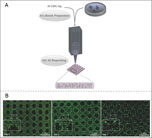Published online by Cambridge University Press: 03 October 2017

To gain a better understanding of the underlying mechanisms of neurological disease, relevant tissue models are imperative. Over the years, this realization has fuelled the development of novel tools and platforms, which aim at capturing in vivo complexity. One example is the field of biofabrication, which focuses on fabrication of three-dimensional (3D) biologically functional products in a controlled and automated manner. Herein, we provide a general overview of classical 3D cell culture platforms, particularly in the context of neurodegenerative disease. Subsequently, the focus is put on bioprinting-based biofabrication, its potential to advance 3D neuronal cell culture and, to conclude, the relevant translational bottlenecks, which will need to be considered as the field evolves.